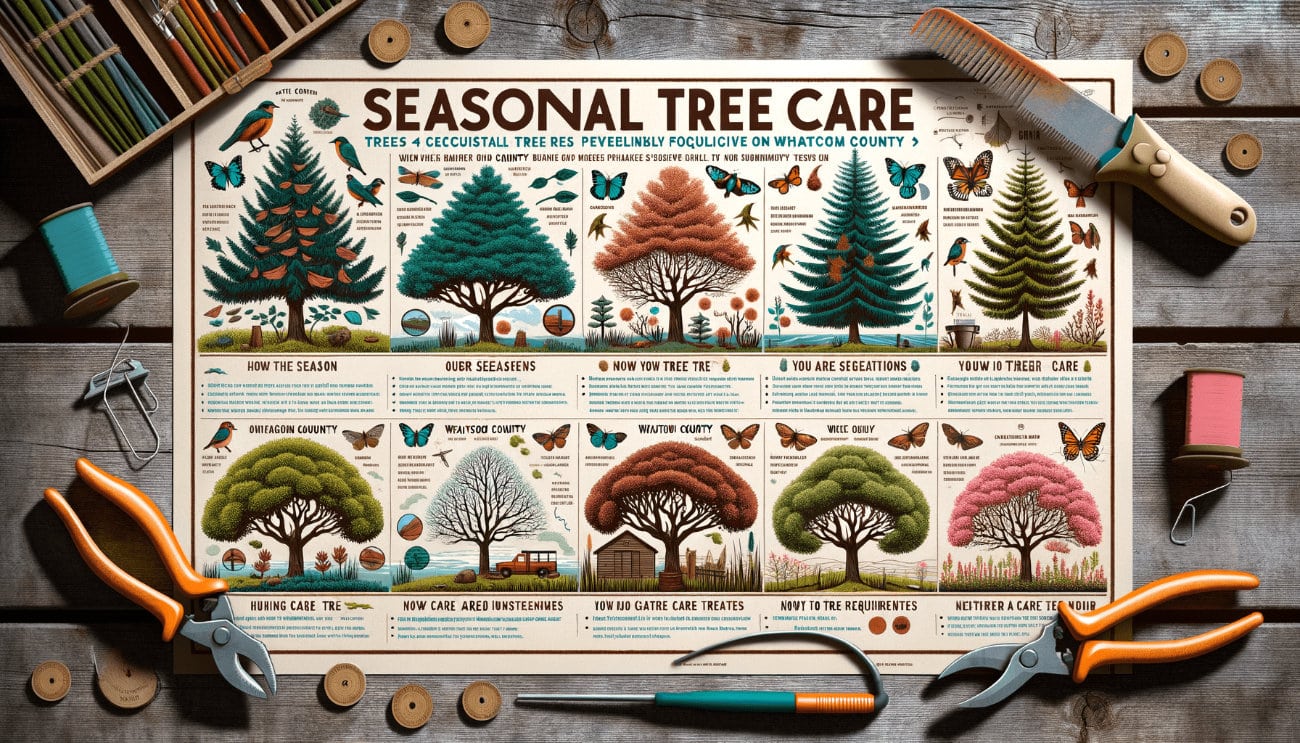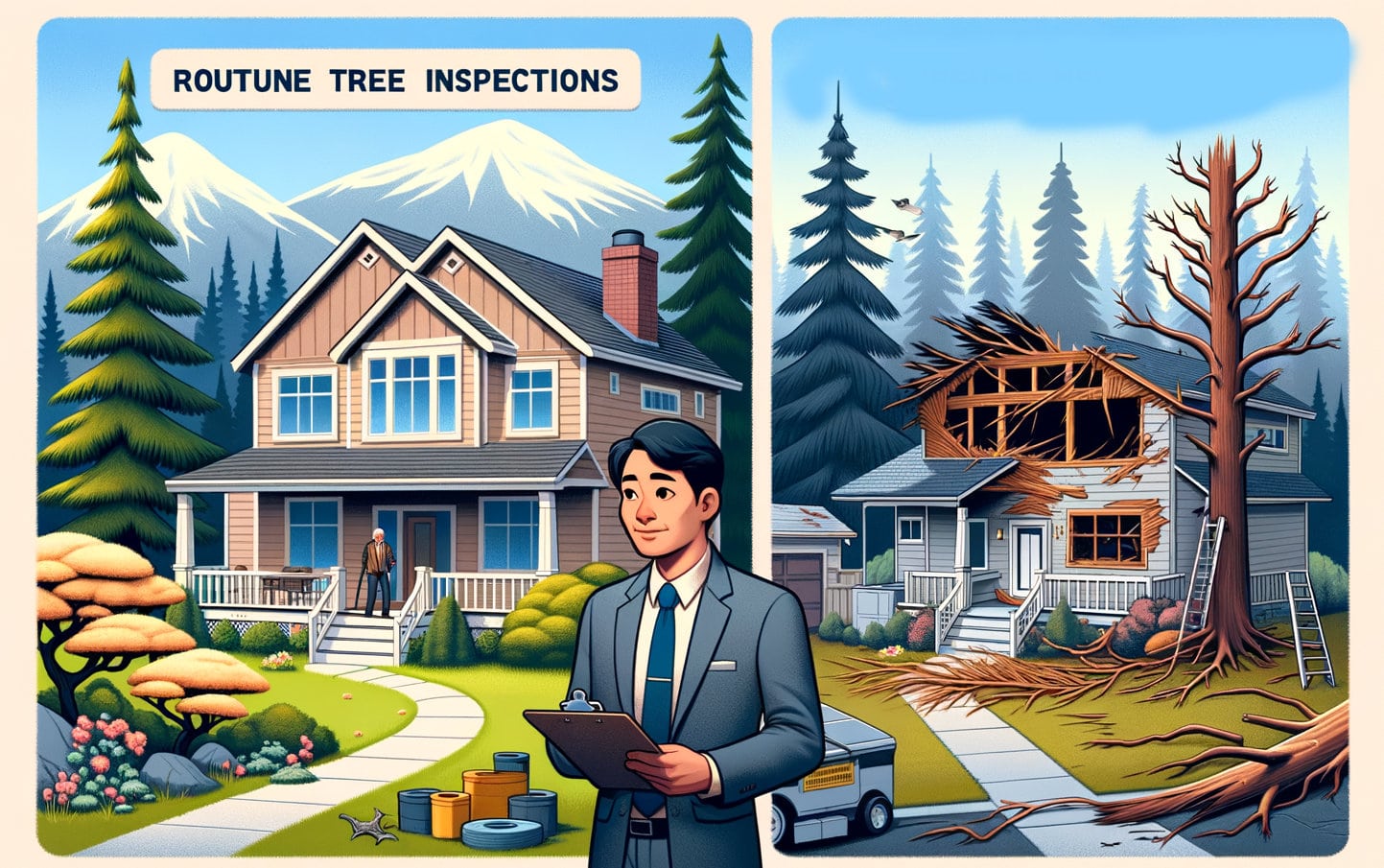Understanding the Importance of Seasonal Tree Care in Whatcom County
Appreciating the Unique Climate of Whatcom County
Whatcom County’s distinct climate significantly affects tree care. With a maritime climate, our region is known for mild, wet winters and dry summers, which can have different effects on tree growth and health.
Understanding this climate is the first step towards a successful seasonal tree care routine.
Crucial Spring and Summer Care
Spring in Whatcom County sees an increase in temperatures and daylight hours, making it a critical time for tree care. This period marks the beginning of the growing season, and it is essential to remove dead or damaged branches that could potentially drain the tree’s energy. Proactive pest control methods should also be implemented as insects start to come out during this time.
As we transition into the summer, hydration for your trees becomes crucial due to the dryer weather. While most mature trees will survive just fine, newly implanted ones might require additional watering. Remember to water deeply to encourage root growth but do so sparingly to avoid overwatering. The addition of mulch around the tree base will help retain moisture and regulate soil temperature.
Autumn and Winter Tree Care Tips
In autumn, tree maintenance should focus on preparing for the cold winter months. Check for any signs of disease or damage that could be exacerbated by frost and wind. Dead branches should be pruned to reduce the risk of breaking and damaging the tree further during windy winter storms. Furthermore, consider wrapping younger trees in a burlap wrap to protect them from the low temperatures and potentially corrosive road salt.
Winter-season tree care in Whatcom County bears its own set of challenges with the wet and freezing conditions. The primary goal during this time should be to protect your trees, particularly young and vulnerable ones, from harsh conditions. Regular inspections for disease or damage such as ice-cracked branches are necessary, with prompt removal of diseased or damaged sections as required.
Remember, good seasonal tree care in Whatcom County involves understanding the specific needs of your trees during each season and adapting your care routine accordingly. This tailored approach will ensure that your trees stay healthy and vibrant throughout the year.
Spring Tree Care Tips for Whatcom County Homeowners
Understanding the Climate of Whatcom County
Whatcom County, situated in the northwest corner of Washington, experiences a climate that is both coastal and mountainous. This means temperatures range from mild to cold, with wet winters and summers that are typically dry. The understanding of the local weather patterns is crucial for the care of trees located here. Homeowners should monitor temperature fluctuations and levels of rainfall to decide on the optimal time for all tree care activities.
Spring Pruning: An Essential Task
One of the first tasks you want to take care of as a Whatcom County homeowner every spring is tree pruning. Spring is a good time because most trees are still dormant, reducing the risk of transmitting diseases or attracting pests. You should remove dead, damaged, or diseased branches to promote new growth and help prevent the spread of disease. Always remember to use clean, sharp tools for pruning, as dull or dirty tools can cause damage and increase disease susceptibility.
Selecting and Planting New Trees
Spring is also an excellent time for planting new trees. Before planting, consider the tree species that are native to Whatcom County such as Western Red Cedar, Douglas Fir, and Western Hemlock. These species are naturally adapted to the local climate and soil conditions, so they will likely thrive better than non-native varieties. When planting, ensure the hole is twice the width of the root ball and at a depth where the top root sits level with or slightly above the ground surface. This helps promote root development and ensures the tree’s stability.
Mulching and Watering Practices
Appropriate mulching and watering are key to keeping trees healthy in the spring. Mulch helps retain soil moisture, maintain soil temperature, and limit weed growth. A layer of organic mulch around the base of a tree, not exceeding 3 inches in depth, can greatly benefit its growth. When it comes to watering, the amount depends on the tree size and species, but generally, a deep soaking once a week is advisable.
Pest and Disease Management
Lastly, spring is a time when pests and diseases can become active. Regularly inspect your trees for signs of problems. If you notice changes such as leaf discoloration, wilting, or unusual insect activity, consider reaching out to an arborist or a local extension office for assistance.
Remember, effective tree care is a long-term investment that can lead to substantial returns. Healthy, beautiful trees not only enhance the appearance of your property but also contribute positively to the overall environment of Whatcom County.
Whatcom County’s Summer Tree Maintenance Advice
Understanding Whatcom County’s Unique Climate
Whatcom County, Washington, is characterized by a diverse climate, with warm dry summers and rainy winters. This unique ecosystem allows a variety of trees to thrive. However, it also necessitates that homeowners become aware of different summer tree care strategies to maintain the health and quality of their trees.
Watering Strategies for Summer Months
During the summer months, proper hydration is essential for the health of your trees. While many trees in Whatcom County are adapted to survive in dry conditions, summer droughts can still cause significant stress. To mitigate this, it is recommended to water deeply and infrequently. This method encourages roots to grow deeper into the soil, promoting stronger trees. Water early in the morning or late in the evening to reduce evaporation.
Pruning and Mulching Techniques
Summer is an excellent time to prune your trees for shaping, as many trees have completed their growth cycle. Pruning should be done sparingly, removing only dead, diseased, or damaged branches to avoid unnecessary stress on the tree. When pruning, make clean cuts close to the branch collar to facilitate healing.
Mulching is another critical summer tree care strategy in Whatcom County. A layer of organic mulch around the base of your trees can help conserve soil moisture, maintain soil temperature, and prevent weed growth. Ensure the mulch isn’t piled against the trunk of the tree to avoid rot and insect problems.
Pest Management
Whatcom County’s lush environment can unfortunately attract pests and diseases during the summer months. Regular inspection of your trees for signs of infestation or disease is key. Watch out for symptoms like discoloration, wilting, or unusual leaf drop. If you notice any of these signs, seek the advice of a certified arborist.
These tips should help you maintain the health and beauty of your trees in Whatcom County during the summer. Remember, each tree is unique and may require slightly different care – understanding your trees’ specific needs will ensure they continue to thrive in this beautiful part of Washington.
Autumn Tree Care Strategies for Whatcom County Dwellers
Understanding the Unique Climate of Whatcom County
To develop a successful autumn tree care strategy in Whatcom County, Washington, it’s vital to understand the local climate. This area features a maritime climate that is generally mild and moist, yet fall brings changes that pose challenges for trees. During this season, there’s usually increased precipitation, and colder temperatures can stress trees, especially those that aren’t native to the Pacific Northwest.
Fall Fertilization and Mulching
Autumn is an excellent time to fertilize your trees in Whatcom County. Fall fertilization helps to restore nutrients in the soil and provides nourishment for trees as they prepare for winter dormancy. Apply an organic or slow-release fertilizer at the base of the tree according to package instructions, and always water thoroughly after application.
Mulching is also an essential autumn tree care strategy. Mulch serves several important purposes: it retains moisture in the soil, suppresses weed growth, and protects the tree’s roots from temperature extremes. Apply a layer of organic mulch, like composted wood chips, around the base of your trees (avoiding direct contact with the trunk) to increase their resilience to the coming winter weather.
Pruning and Disease Prevention
Fall is an ideal time for pruning most tree species in Whatcom County, though timing depends on the specific type of tree. Pruning during the cooler fall season helps reduce sap loss and minimizes the risk of infection or infestation by pests. However, it’s crucial to know how and what to prune – improper pruning can further stress the tree and lead to health problems. Always remove dead or diseased branches, but be wary of over-pruning as trees need their foliage to produce energy for growth.
Finally, disease prevention is key during the autumn months. With the increased dampness and cooler weather, certain fungi and diseases can thrive. Regularly check your trees for signs of disease such as discolored leaves, cankers, or unusual growths. If you spot any concerning symptoms, reach out to a local arborist for an assessment. They can provide guidance on treatment and help ensure that your trees will thrive in the distinct climate of Whatcom County.
Winter Tree Care Tips: Preparing for Whatcom County’s Cold Months
Whatcom County, Washington is known for its cold winter months and homeowners must be prepared to take good care of their trees during this period. By implementing a few key winter tree care tips, your trees can stay healthy and strong even in the toughest of winters.
Proper Pruning
Pruning trees is an essential task that should not be overlooked during winter. Pruning not only helps in maintaining the overall appearance and health of the tree but also safeguards against possible hazards such as falling branches. Residents of Whatcom County should consider getting their trees pruned in late fall or early winter. This is because deciduous trees are dormant during this period, making it easier to see the tree’s structure and identify parts that need pruning. However, avoid heavy pruning as it could lead to extensive sap loss.
Tree Wrapping
To protect younger trees from the harsh winter cold, it’s beneficial to wrap them. The main purpose of tree wrapping is to shield the bark from extreme temperature fluctuations which can lead to sunscald, a kind of tree injury resulting from abrupt temperature changes. Using burlap or tree wraps made of crepe paper is recommended. Start the wrapping process from the base of the tree and continue upwards to the first set of branches. The material should be removed as soon as temperatures start to remain above freezing in spring.
Hydration and Mulching
Before the onset of winter, it’s important to ensure that your trees are well watered especially those recently planted. This hydration prepares them for the freeze and reduces the risk of desiccation. Following this, apply a layer of organic mulch around the base of the tree. Mulch serves two main purposes: it acts as insulation, shielding the roots from severe cold, and it promotes moisture retention in the soil, preventing it from drying out completely. The mulch layer should be about 2 to 4 inches thick and extend out to the tree’s drip line. Avoid piling mulch against the trunk of the tree as it may promote the growth of harmful fungi.
By employing these tree care strategies, homeowners in Whatcom County can equip their trees to withstand the winter cold and remain vibrant and healthy, ready to thrive when spring arrives.

